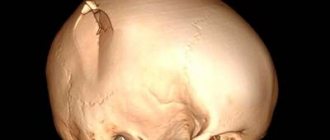Anatomy of the human subcortex - information:
In addition to the gray cortex on the surface of the hemisphere, there are also accumulations of gray matter in its thickness, called the basal ganglia and constituting what is called the subcortex . Unlike the cortex, which has the structure of screen centers, the subcortical nuclei have the structure of nuclear centers.
There are three clusters of subcortical nuclei : corpus striatum, claustrum and corpus amygdaloideum.
1. Coprus striatum, striatum , consists of two parts that are not completely separated from each other - the nucleus caudatus and the nucleus lentiformis.
A. Nucleus caudatus, caudate nucleus , lies above and medial to the nucleus lentiformis, separated from the latter by a layer of white matter called the internal capsule, capsula interna. The thickened anterior part of the caudate nucleus, its head, caput nuclei caudati, forms the lateral wall of the anterior horn of the lateral ventricle, while the posterior thinned section of the caudate nucleus, corpus et cauda nuclei caudati, stretches back along the bottom of the central part of the lateral ventricle; The cauda wraps around the upper wall of the lower horn. On the medial side, the nucleus caudatus is adjacent to the thalamus, separated from it by a strip of white matter, stria terminalis. In front and below, the head of the caudate nucleus reaches the substantia perforata anterior, where it connects with the nucleus lentiformis (with the part of the latter called putamen). In addition to this wide connection of both nuclei on the ventral side, there are also thin strips of gray matter, interspersed with white bundles of the internal capsule. They gave rise to the name “striatum”, corpus striatum.
B. Nucleus lentiformis, lentiform nucleus , lies lateral to the nucleus caudatus and thalamus, separated from them by the capsula interna. On a horizontal section of the hemisphere, the medial surface of the lenticular nucleus, facing the internal capsule, has the shape of an angle with the apex directed towards the middle; the anterior side of the angle is parallel to the caudate nucleus, and the posterior side is parallel to the thalamus. The lateral surface is slightly convex and faces the lateral side of the hemisphere in the region of the insula. Anteriorly and ventrally, as already indicated, the lenticular nucleus merges with the head of the nucleus caudatus. In a frontal section, the lentiform nucleus has the shape of a wedge, the apex of which faces the medial side and the base faces the lateral side.
The lenticular nucleus is divided into three segments by two parallel white layers, laminae medullares, of which the lateral, dark gray, is called the putamen, and the two medial, lighter ones, are collectively called the globus pallidus , globus pallidus. Differing already in its macroscopic appearance, the globus pallidus also has a histological structure that is different from other parts of the striatum.
Phylogenetically, globus pallidus is an older formation (paleostriatum) than putamen and nucleus caudatus (neostriatum). In view of all these features, globus pallidus is currently classified into a special morphological unit called pallidum, while the designation striatum is reserved only for putamen and nucleus caudatus. As a result, the term “lenticular nucleus” loses its previous meaning and can only be used in a purely topographical sense, and instead of the previous name corpus striatum, the caudate and lenticular nucleus are called the striopallidal system.
The striopallidal system is the main part of the extrapyramidal system, and in addition, it is the highest regulatory center of autonomic functions in relation to heat regulation and carbohydrate metabolism, dominating over similar autonomic centers in the hypothalamus.
2. Claustrum, fence , is a thin plate of gray matter located in the region of the insula, between it and the putamen. It is separated from the latter by a layer of white matter, capsula externa, and from the insular cortex by a layer called capsula extrema.
3. Corpus amygdaloideum, the amygdala, is located under the putamen at the anterior end of the temporal lobe. Corpus amygdaloideum apparently belongs to the subcortical olfactory centers and to the limbic system. It ends in a bundle of fibers coming from the olfactory lobe and substantia perforata anterior, noted in the description of the thalamus under the name stria terminalis.
The limbic system is a complex of formations of the telencephalon, diencephalon and mesencephalon, involved in the regulation of various autonomic functions, maintaining the constancy of the internal environment of the body (homeostasis) and in the formation of emotionally charged behavioral reactions. Therefore, some authors designate the limbic system as the “visceral brain.” The main part of it consists of the structures of the cerebral cortex, located mainly on the medial surface of its hemispheres, and subcortical formations closely associated with them, namely: amygdaloid region, stria terminalis, hypothalamus, hippocampus, fornix, septal region, mammillary bodies, mastoid-thalamic fascicle , thalamus, cingulate gyrus. On the medial surface of the cerebral hemispheres, the limbic system is represented by the cingulate and parahippocampal gyri.
Subcortical functions,
a set of physiological processes associated with the activity of individual
subcortical structures of the brain
or their system.
From an anatomical point of view, subcortical include all ganglion formations lying between the cerebral cortex
and
the medulla oblongata.
However, in functional terms, the term “P. f." It was customary to designate the functions of the “nearest subcortex” (I.P. Pavlov), which has closer connections with the cerebral cortex and includes subcortical formations lying between the cortex and the quadrigeminal (thalamus, hypothalamus, caudate, globus pallidus, etc. ). Subsequently, in connection with the development of the physiology of the reticular formations of the thalamus and brainstem, it was shown that these formations are directly related to the functions of the cerebral cortex and are associated with complex relationships. The cerebral cortex, being the main organ of new temporary connections and the integrator of complex adaptations to the outside world, can perform this function only if it continuously receives generalized and local activating ascending influences from the subcortical apparatus. Elimination of these influences immediately destroys the finest cortical integration, loss of consciousness occurs, a transition to a sleepy state occurs, the ability of the cerebral cortex to carry out associative activity reversibly disappears, etc.
Given this activating influence of subcortical formations on the cerebral cortex, Pavlov believed that “emotions give strength to cortical cells” and that the cortex is always under the influence of the “blind force” of the subcortex. All these data make it difficult to separately consider both the cerebral cortex and subcortical formations. However, despite the indicated feature of cortical-subcortical relationships, each of these levels of nervous organization has very specific functional properties, localization and contributes its own special share to the final integrative activity of the whole organism. This circumstance justifies the identification of the physiological characteristics of subcortical structures. See also Hypothalamus, Optic thalamus, Corticovisceral relations, Limbic system, Reticular formation.
Lit.:
Pavlov I. P., Complete. collection soch., vol. 2-4, M. - L., 1951; Anokhin P.K. About the specific action of the reticular formation on the cerebral cortex, in the book: Electroencephalographic study of higher nervous activity, M., 1962; Mechanisms of the whole brain. Sat. Art., trans. from English, M., 1963.
P.K. Anokhin.
Table of contents
Structure
Let's look at the design of the cores. The subcortical nuclei in their structure are formed from Golgi neurons of the second type. They are similar in features such as shortened dendrites and thin axons, and the cells are small in size.
The subcortical nuclei of the hemispheres perform the function of connecting them with other devices of the brain. They consist of the following components:
- Caudate nucleus. It is distinguished by the presence of a network of neurons that interact with sensory areas and form pathways that are autonomous in nature.
- Lenticular body. Located outside the thalamus and nucleus. From the point of anatomical location, they are separated by an external capsule. Located on parallel planes with the thalamus and nucleus.
- Pale ball. It is recognized as one of the ancient formations of the higher nervous system.
In addition, the subcortical nuclei of the brain consist of additional structures such as the velum, which acts as an insightful layer of gray matter that is located between the putamen and the nucleus. They also include the amygdala, which consists of a collection of gray matter and is located in the temporal lobe under the putamen.
Pathological states of nuclei
You will be interested in:System analysis: basics of system analysis, textbooks and their authors
Among the diseases of the subcortical nuclei the following are distinguished:
Among other things, pathologies can manifest themselves with general symptoms, such as:
- general deterioration of health;
- weakness and fatigue;
- violation of muscle tone;
- tremor;
- impoverishment of facial expressions;
- memory impairment and clouding of consciousness.
SNO GOU VPO NSMU Roszdrav - EstheticLife.ru
Diencephalon, diencephalon ,
- is a derivative of the anterior medullary bladder.
It consists of: the thalamic brain, thalamencephalon ,
- the center of the afferent pathways, and the hypothalamus,
hypothalamus ,
- the highest autonomic center.
The cavity of the diencephalon is the third ventricle, ventrieulus tertius .
Borders:
anterior ventral
— anterior edge of chiasmae opticae;
posterior ventral
- anterior edge of the substantia perforata posterior;
anterior dorsal
- terminal strip,
stria terminalis ,
which is also the border between the thalamus and the internal capsule;
posterior dorsal
- a groove separating the superior colliculus from the thalamus.
The thalamencephalon consists of three sections: the optic thalamus, thalamus ,
suprathalamic region,
epithalamus ,
and postthalamic region,
metathalamus .
Thalamus
is a paired ovoid formation, the anterior end of which is called
tuberculum anterius thalami .
The more massive posterior end forms a cushion,
pulvinar .
Moreover, if the anterior end represents the centers of the afferent olfactory pathways, then the subcortical centers of vision are located in the pillow.
The free dorsal surface of the thalamus is covered with a layer of white matter, stratum zonale. Along its lateral edge there is a border groove, sulcus
terminalis ,
in which there is a narrow strip,
stria terminalis ,
and along the medial edge there is a medullary strip,
stria medullaris thalami .
Thus, sulcus terminalis et stria terminalis are the boundary between the thalamus and the caudate nucleus [see section “Basal ganglia of the hemispheres”], and stria medullaris separates the dorsal surface of the thalamus from the medial one.
Fig . 6
Diagram of the visual brain
The medial surface of the visual thalamus is free and forms the lateral wall of the third ventricle. The medial surfaces of both thalami are connected to each other by an interthalamic commissure, adhezio
interthalamica ,
which has a cellular structure.
The lower border separating the thalamus from the underlying subthalamic region is sulcus
hypothalamicus ,
which stretches from the interventricular foramen,
foramen interventriculare
(Monroi), to the entrance to the aquaeductus cerebri (Silviev).
The thalamencephalon consists of a large number of neurons, united into nuclei, which are separated from each other by the medullary plate, lamina medullaris thalami.
Thalamic nuclei are divided into six groups: anterior, posterior, medial, lateral, nuclei of the intermediate zone. Wherein:
a) the anterior nuclei are the subcortical centers of smell (the bundle from the corpora mamillaria goes here);
b) posterior nuclei (located in the pulvinar) - subcortical centers of vision;
c) in the remaining nuclei there are sensitive (afferent) pathways, and the lemniscus medialis ends in the lateral nuclei.
Metathalamus
form the lateral and medial geniculate bodies, corpora geniculata lateralia et medialia, into which the handles of the superior and inferior colliculi pass, respectively [see section “Midbrain”]. The corpora geniculata medialia ends with the lemniscus lateralis, so they are subcortical hearing centers. In the corpora geniculata lateralia ends mostly in the tr.opticus (the other part in the pulvinar), so the subcortical centers of vision are located here.
The geniculate bodies are connected to the cortical centers of the corresponding analyzers.
It should be noted that in modern physiological literature the thalamus and metathalamus are often considered as a single thalamic section of the diencephalon.
Epithalamus.
Each stria medullaris, expanding posteriorly, forms a leash triangle,
trigonum habenulae ,
from which the leash extends,
habenula .
The leashes on each side are connected to the unpaired pineal body,
corpus pineale
s.epiphysis.
Between the leashes, in front of the epiphysis, there is a commissure of the leashes, commissura habenularum ,
in the depths of which there is a posterior commissure of the brain,
commissura cerebri posterior .
The pineal gland is an endocrine gland and plays an important role in regulating the processes of puberty (inhibits the synthesis of sex hormones) and indirectly affects water-salt metabolism.
Summary.
The thalamencephalon contains:
1) subcortical centers of vision: pulvinar, corpora geniculata lateralia (plus the nuclei of the superior colliculi of the midbrain);
2) subcortical hearing centers: corpora geniculata medialia (plus the nuclei of the inferior colliculi of the midbrain);
3) subcortical centers of smell: anterior nuclei of the thalamus;
4) the pineal gland, or pineal body, is one of the main endocrine glands;
5) thalamus - the highest subcortical center of all types of sensitivity except auditory. He is responsible for:
a) distribution of information (cortex, striopallidal system [see section “Basal ganglia of the hemispheres”], hypothalamus, etc);
b) accuracy of localization of irritation;
c) accuracy of perception of the degree of irritation;
d) memory formation
Hypothalamus
, forms the lower parts of the diencephalon.
It includes the optic tract, tr . opticus ,
optic chiasma,
chiasma optica ,
gray tubercle,
tuber cinereum ,
funnel,
infundibulum ,
mastoid bodies,
corpora mamillaria
and subthalamic region,
regio subtha - lamica ,
which is a direct continuation of the cerebral peduncles and located under the sulcus hypothalamicus.
External building.
Optic chiasm,
chiasma optica. It includes nn.optici and performs incomplete crossover here. At the back, the optic tracts emerge from the chiasm, trr.optici. Each tr.opticus goes around the cerebral peduncles at the posterior edge of the substantia perforata anterior and ends, partly, in the pulvinar and corpus geniculatum laterale, and partly in the superior colliculus, colliculi superior es.
Gray hillock,
The tuber cinereum is located between and slightly behind the optic tracts. Downwards it passes into the funnel, infundibulum, through which the hypothalamus is connected to the pituitary gland.
Function: higher vegetative center that regulates heat exchange.
[On the preparation you will rarely be able to see the pituitary gland, since it is located in the sella turcica, and when the brain is removed from the skull, it is usually torn off from the infundibulum].
mastoid bodies,
corpora mamillaria, are located between the gray tubercle located in front and the substantia perforata posterior - in the back.
Function: subcortical center of smell.
Internal structure.
In the hypothalamus, there are four main areas of accumulation of nerve cells: regiones
hypothalamic : anterior , intermedia , posterior
et
regio subthalamica .
They contain about 30 cores.
The neurons of the nuclei produce a secretion that is transported along the processes of these cells to the pituitary gland - this is the so-called. neurosecretory nuclei.
Cell processes form the hypothalamic-pituitary bundle.
Of the nuclei mentioned, the following are considered particularly important:
- in the regio hypothalamica anterior - such nuclei as: supraoptic, nucl . supraopticus ,
paraventricular,
nucl . paraventricularis ;
- in regio intermedia - infero- and superomedial nuclei, nucll . hypothalamici
ventro -
et
dorsomedalis ,
dorsal nucleus, infundibulum nucleus,
nucl . infundibuli ,
gray tuberous nuclei;
__ in the regio hypothalamica posterior the largest are the posterior nucleus, nucl . hypothalamicus
posterior ,
medial and lateral nuclei of the mastoid body,
nucll . corporis mamillaris medialis
et
lateralis .
— Lewisovo
body, corpus subthalamicus Luysi and the red nucleus, nucl, protrudes here.
ruber .
Summary .
The hypothalamus is the highest autonomic center. The neurosecretion of the hypothalamic nuclei affects the functions of the glandular cells of the pituitary gland, and the pituitary gland, in turn, regulates the activity of other endocrine glands.
Rice. 7 Scheme of the neurosecretory nuclei of the hypothalamus
Correspondent of the project " EstheticLife "
Serova Ksenia
REPORT on the topic: The role of subcortical structures in mental activity.
MINISTRY OF EDUCATION AND SCIENCE OF RUSSIA
FEDERAL STATE BUDGET EDUCATIONAL INSTITUTION
HIGHER EDUCATION
"NIZHNY NOVGOROD STATE PEDAGOGICAL UNIVERSITY NAMED AFTER KOZMA MININA"
Faculty of Psychology and Pedagogy
Department of Special Pedagogy and Psychology
Direction of training: 44.03.03 Special (defectological) education
Field of training: Oligophrenopedagogy
REPORT
on the topic: The role of subcortical structures in mental activity
STUDENT(KA) __________________ Minezhetdinova Dinara Ramilievna
(personal signature)
MANAGER ________________ Cand. psychol. Sciences, Associate Professor Chesnokova L. S.
(personal signature)
Nizhny Novgorod – 2021
The basis for the functioning of the psyche is the activity of the central nervous system.
Thanks to the research of the Spanish histologist Ramon y Cajal, the Swiss psychiatrist Forel and Bekhterev, it was found that the entire nervous system consists of independent units - neurons, that is, nerve cells with processes.
The neuron performs a number of important functions, which include: perceptive, integrative, mnestic, conductive, transmitting.
The central nervous system consists of the spinal cord and the brain. The brain consists of the brain stem, the cerebellum and two hemispheres, which include the cortex and subcortical structures (olfactory brain and basal ganglia).
The brain as a substrate of mental processes is a single supersystem, a single whole, consisting, however, of differentiated sections (areas or zones) that perform different roles in the implementation of mental functions. This main position of the theory of localization of higher mental functions of a person is based not only on comparative anatomical, physiological data and the results of clinical observations, but also on modern information about the basic principles of the structure of the human brain.
All data (anatomical, physiological, and clinical) indicate the leading role of the cerebral cortex in the cerebral organization of mental processes. The cerebral cortex (and above all, the neocortex) is the most differentiated part of the brain in structure and function. In the recent past, the cerebral cortex was given exceptional importance; it was considered the only substrate of mental processes. This point of view was supported by the doctrine of conditioned reflexes of I.P. Pavlov, who considered the cerebral cortex the only brain formation where conditioned connections - the basis of mental activity - can be closed.
Mental activity is extremely diverse in content. Its simplest type is stereotypical activity, carried out at the level of conditioned reflexes developed in response to familiar stimuli repeated in a certain sequence (human habits, simple work skills). The most complex type of mental activity is creativity. As a result of creative activity, a qualitatively new product is created (work of art, invention, etc.).
The basis of mental activity is the mechanism of satisfying the needs of different levels (physiological, psychological, social, spiritual) through the self-realization of the individual.
Mental activity improves and becomes more complex due to the process of cognition.
As a result of cognition, a person acquires knowledge about the world around him and himself, the ability to apply the acquired knowledge in his activities, especially work, and adapts more effectively to changes in the external environment.
The process of mental activity includes 5 stages:
1) obtaining information and evaluating it;
2) choosing a goal to be achieved as a result of the activity;
3) activity planning, i.e. selection of means and methods by which the goal can be achieved;
4) the actual activity using selected means and methods;
5) assessment of the results obtained (the degree of achievement of the goal).
Through cognitive processes and personal experience (trial and error), mental activity becomes more effective and mature. A person gains the ability to draw the best conclusion from a variety of options, adequately assess the situation, control emotions, and take responsibility for their actions.
Subcortical functions, a set of physiological processes associated with the activity of individual subcortical structures of the brain or their system. From an anatomical point of view, subcortical include all ganglion formations lying between the cerebral cortex and the medulla oblongata. However, in functional terms, the term “P. f." It was customary to designate the functions of the “nearest subcortex” (I.P. Pavlov), which has closer connections with the cerebral cortex and includes subcortical formations lying between the cortex and the quadrigeminal (thalamus, hypothalamus, caudate, globus pallidus, etc. ).
Subsequently, in connection with the development of the physiology of the reticular formations of the thalamus and brainstem, it was shown that these formations are directly related to the functions of the cerebral cortex and are associated with complex relationships. The cerebral cortex, being the main organ of new temporary connections and the integrator of complex adaptations to the outside world, can perform this function only if it continuously receives generalized and local activating ascending influences from the subcortical apparatus. Elimination of these influences immediately destroys the finest cortical integration, loss of consciousness occurs, a transition to a sleepy state occurs, the ability of the cerebral cortex to carry out associative activity reversibly disappears, etc.
Given this activating influence of subcortical formations on the cerebral cortex, Pavlov believed that “emotions give strength to cortical cells” and that the cortex is always under the influence of the “blind force” of the subcortex. All these data make it difficult to separately consider both the cerebral cortex and subcortical formations. However, despite the indicated feature of cortical-subcortical relationships, each of these levels of nervous organization has very specific functional properties, localization and contributes its own special share to the final integrative activity of the whole organism. This circumstance justifies the identification of the physiological characteristics of subcortical structures. See also Hypothalamus, Optic thalamus, Corticovisceral relations, Limbic system, Reticular formation.
The cerebral cortex is the latest evolutionary and functionally highest formation of the nervous system. The cortex covers the brain on all sides; it has many grooves and convolutions, which allows it to occupy a large surface area. On a section, its gray color differs from the white matter of the brain, consisting of nerve fibers. The gray color of the cortex is given by the nerve cells that form it. Each hemisphere consists of four lobes: frontal, temporal, parietal and occipital. The cortex analyzes and synthesizes signals coming from the external world and the internal environment of the body. The cortex has projection and association zones. Projection zones are connected with neurons of the subcortical centers. Association zones do not have a direct connection with subcortical centers, but are connected by a bilateral temporary connection with projection centers. They play an important role in the implementation of higher nervous activity.
An important issue is the question of functional localization in the cerebral cortex. The basis of the modern doctrine of localization of functions was laid by the French physician Broca, who discovered the motor center of speech in 1861. A quarter of a century later, Wernicke discovered the speech understanding center. Currently, such projection centers are known as the centers of general sensitivity, kinesthetic sensitivity, auditory, visual, gustatory, olfactory, vestibular sensitivity, etc. The associative centers include the acoustic center of speech, the motor center of speech, the center for visual analysis of written speech, the motor center of written speech. speech, etc. The problem of localization cannot be understood too simplistically, as if the found areas are themselves responsible for this or that mental phenomenon, and themselves, without the participation of other parts of the central nervous system, perform this function. Any function is the result of the holistic functioning of the brain. Complex mental processes are realized by the joint activity of an entire system of organs, that is, a complex functional system. Even a relatively simple voluntary movement is realized by a complex functional system, including a whole complex of both sensory (afferent) and motor (efferent) impulses. The principles of the functional organization of the work of the central nervous system were developed by Luria. According to his concept, there are three main blocks in the central nervous system, each of which performs its own functions in the organization of mental activity.
Thus, the normal functioning of the psyche is ensured by the integral activity of the entire nervous system and the body as a whole, that is, one might say, neurosomatic integration.
Subcortical structures were assigned an auxiliary role; they were primarily recognized for their energetic and activation functions. However, as knowledge about subcortical formations accumulates, ideas about their participation in the implementation of various mental processes have changed. Currently, the point of view about the important and specific role of not only cortical, but also subcortical structures in mental activity with the leading participation of the cerebral cortex has become generally accepted. These ideas are supported by materials from stereotactic operations on deep brain structures and the results of electrical stimulation of various subcortical formations, as well as clinical observations of patients with lesions of various subcortical structures.
- "Biology. A modern illustrated encyclopedia." Ch. ed. A. P. Gorkin; M.: Rosman, 2006.
- Pavlov I. P., Complete. collection soch., vol. 2-4, M. - L., 1951; Anokhin P.K. About the specific action of the reticular formation on the cerebral cortex, in the book: Electroencephalographic study of higher nervous activity, M., 1962; Mechanisms of the whole brain. Sat. Art., trans. from English, M., 1963.
The structure of the subcortical region of the brain. Diencephalon
Striopallidar system
In the thickness of the white matter of the cerebral hemispheres there are clusters of gray matter called the subcortical nuclei (basal ganglia). These include the caudate nucleus, the lenticular nucleus, the cervical nucleus, and the amygdala (Fig. 6). The lenticular nucleus, located outside the caudate nucleus, is divided into three parts. It contains a shell and two pale balls.
Rice. 6. Subcortical nuclei:
1 – caudate nucleus; 2 – lentiform nucleus; 3 – visual thalamus.
A – horizontal section: a – fence; b – shell; c and d – globus pallidus;
B-frontal section: a – globus pallidus; b – shell
Functionally, the caudate nucleus and putamen are united into the striatum (striatum), and the globus pallidus, together with the substantia nigra and red nuclei located in the cerebral peduncles, form the corpus pallidus (pallidum).
Together they represent a very functionally important formation - the striopallidal system. In terms of morphological features and phylogenetic origin (their appearance at a certain stage of evolutionary development), the pallidum is a more ancient formation than the striatum.
The striopallidal system is an important part of the motor system. It is part of the so-called pyramid system. In the motor zone of the cerebral cortex, the motor - pyramidal - path begins, along which the order to perform this or that movement follows.
The extrapyramidal system, an important part of which is the striopallidum, being included in the motor pyramidal system, takes an auxiliary part in ensuring voluntary movements.
At a time when the cerebral cortex was not yet developed, the striopallidal system was the main motor center that determined the behavior of the animal. Due to the striopallidal motor apparatus, diffuse, mass movements of the body were carried out, ensuring movement, swimming, etc.
With the development of the cerebral cortex, the striopallidal system passed into a subordinate state. The main motor center became the cerebral cortex.
The striopallidal system began to provide the background, readiness for movement; Against this background, fast, precise, strictly differentiated movements are carried out, controlled by the cerebral cortex.
To perform a movement, it is necessary that some muscles contract and others relax, in other words, an accurate and coordinated redistribution of muscle tone is needed.
This redistribution of muscle tone is precisely carried out by the striopallidal system. This system ensures the most economical consumption of muscle energy during movement. Improving movements in the process of learning to perform them (for example, practicing to the limit the perfect running of a musician’s fingers, the swing of a mower’s hand, the precise movements of a car driver) leads to gradual economization and automation.
This possibility is provided by the striopallidar system.
It was noted above that, phylogenetically, the striatum is a younger formation than the corpus pallidus. An example of pallidal organisms is fish.
They move in the water using powerful throwing movements of the body, without “concerning” about saving muscle energy. These movements are relatively precise and powerful. However, they are energetically wasteful. In birds, the striatum is already well defined, which helps them more carefully regulate the quality, accuracy and quantity of movements. Thus, the pallidum inhibits and regulates the activity of the pallidal system (since phylogenetically younger formations control and inhibit more ancient ones).
Motor acts of a newborn are pallidal in nature: they are uncoordinated, jerky and often unnecessary. With age, as the striatum matures, the child’s movements become more economical, sparing, and automated.
The striopallidal system has connections with the cerebral cortex, the cortical motor system (pyramidal) and muscles, formations of the extrapyramidal system, the spinal cord and the visual thalamus.
The other basal ganglia (the cervical nucleus and the amygdala) are located lateral to the lenticular nucleus. The amygdala is part of another functional system - the limbic-reticular complex.
Optic thalamus
The optic thalamus and the subtubercular region (hypothalamus) develop from the intermediate vesicle, and the third ventricle develops from the cavity of the intermediate vesicle.
optic thalamus,
or
thalamus,
located on the sides of the third ventricle and consists of a powerful accumulation of gray matter.
The optic thalamus is divided into the visual thalamus itself, the suprathalamic area (the suprathalamic area, or epilamus), and the suprathalamic area (the metathalamic area, or metathalus). The bulk of the gray tubercle is the thalamus (see Fig. 7).
Rice. 7. Topography of the thalamus
1 – thalamus; 2 – body of the caudate nucleus; 3 – body of the lateral ventricle; 4 – corpus callosum; 5 – medulla oblongata.
In it there is a protrusion of the cushion, behind which there are two elevations - the external and internal geniculate bodies (they enter the subcutaneous region).
There are several nuclear groups in the thalamus.
The epithalamus region, or epithalamus, consists of the pineal gland and the posterior commissure of the brain.
The subcutaneous region, or metathalamus, includes the geniculate bodies, which are the elevation of the thalamus. They lie outward and inferior to the thalamic cushion.
The subcutaneous region, or hypothalamus, lies downward from the thalamus, has a number of nuclei lying in the walls of the third ventricle.
The visual thalamus is an important stage on the path to all types of sensitivity. Sensitive pathways approach it and are concentrated in it - touch, pain, temperature, visual tracts, auditory pathways, olfactory pathways and fibers from the extrapyramidal system. The next stage of transmission of sensitive impulses begins from the neurons of the visual thalamus - to the cerebral cortex.
At a certain stage in the evolution of the nervous system, the thalamus was a center of sensitivity, just as the striopallidal system was a mechanism of movement. As the cerebral cortex appeared and developed, the main role in the function of the sensitive sphere passed to the cerebral cortex, and the visual thalamus remained only a transfer station of sensitive impulses from the periphery to the cerebral cortex.
Functions
The subcortical nuclei guarantee a full range of functions to strengthen the basic functioning of the whole organism. Their main goals are:
- expression of emotions and facial expressions;
- metabolism in the body;
- the onset of sleep;
- vocabulary and speech;
- metabolism;
- control of the motor sphere;
- heat transfer and heat generation.
All of the listed functions of the subcortical nuclei are determined by the number of connections with neighboring structures.
What is the structure of the basal ganglia?
The basal ganglia include the striatum, which is divided into the lentiform and caudate nuclei, the amygdala, and the cervical nucleus. This classification is based on the anatomical structure and location of these structures on sections of the cerebral hemispheres.
In recent years, the term “basal ganglia” has come to mean the subthalamic nucleus, substantia nigra and pedunculopontine tegmental nucleus.
The name "striatum" arose from the alternating areas of white and gray matter in horizontal sections. The lenticular and caudate nuclei are connected to each other by thin bridges of gray matter.
The caudate nucleus is located slightly higher and more in the middle of the lentiform nucleus, they are separated by a capsule formed by neurons of the brain or white matter. The anterior part of the caudate nucleus is slightly thickened; it and its tail form the lateral or outer wall of the anterior horn of the lateral ventricle of the brain. The posterior part of the caudate ganglion is thinned and adjacent to the bottom of the lateral ventricle and is located approximately in its middle. The surface of the caudate nucleus, facing the middle, borders the thalamus. They are separated by a narrow strip of white matter in the brain.
Detailed structure
The caudate nucleus in its structure is formed by Golgi neurons of the second type. Their structure has a number of similar characteristics: they have a thin axon and significantly shortened dendrites. These cells are small. The main functions of the caudate nucleus are determined by their connections with other structures of the brain . The caudate nucleus receives descending commands from the extrapyramidal system. This structure has a widespread network of neurons that interact with sensory areas through the globus pallidus and thalamus, forming closed pathways. However, the caudate nucleus actively interacts with other structures of the brain, for example, with the substantia nigra, cerebellum, vestibular ganglia and other structures. Such diverse and stable connections make it possible to say that the basal ganglia of the hemispheres are multifunctional. It participates in the vegetative functions of the whole organism, plays an important role in integrative and cognitive abilities, coordinates and stimulates human motor activity.
The lentiform body is located outward from the caudate nucleus and thalamus, they are separated by the external capsule. The middle surface of the lenticular ganglion has the shape of an angle, with its rounded part facing the median capsule. It is located on parallel planes with the caudate nucleus and thalamus. The surface located inside has a hemispherical shape and is adjacent to the outside of the cerebral hemispheres. Anteriorly, the lentiform nucleus and the head of the caudate nucleus merge. In cross sections, the shape of the lenticular nucleus is similar to a wedge, the wide part of which is directed outward.
The lenticular nucleus is divided by thin strips of white matter into 3 main structures: the darker part is the putamen, the lighter areas form a structure called the globus pallidus. In its histological structure, the globus pallidus differs significantly from the shell and is presented in the form of Golgi cells of the first type; there are much more of them in the human body, and they are much larger than cells of the second type.
The globus pallidus is considered to be one of the most ancient formations of the higher nervous system; it developed much earlier than the putamen and caudate nucleus, constantly underwent changes and improved, but did not lose its importance as the basal ganglia. At the present stage of development of neurology and neurosurgery, it is generally accepted that the lenticular nucleus is only a topographical landmark. While the structure at the junction of the body of the caudate and lentiform nuclei is organized into a striopallidal system.
The striopallidal system is the basis of the extrapyramidal system, and is also the main center for regulating the autonomic functions of the body in the field of thermoregulation and carbohydrate metabolism, significantly exceeding the hypothalamus in its importance.
Additional structures included in the basal ganglia
The fence is a thin layer of gray matter located between the island and the shell, and surrounded on all sides by white matter, which in turn forms 2 capsules: between the fence and the shell is the outer capsule, and the outer capsule separates them from the island.
The basal ganglia of the telencephalon are also represented by the amygdala. This accumulation of gray matter is located in the temporal lobe under the putamen. It is believed that it belongs, like part of the temporal lobe, to the olfactory centers and limbic system of the brain. The amygdala terminates in nerve fibers coming from the anterior perforated substance and the olfactory lobe.
The limbic system, or, as it is sometimes called, the visceral brain, is a very complex structure in its organization, which includes sections of the telencephalon, midbrain and medulla oblongata. Its functions are as multifaceted as its structure; it is responsible for vegetative processes in the body, cognitive activity, brightly colored emotional reactions and active psychological processes, and also maintains constant homeostasis of the body.
What are the subcortical nuclei responsible for in the body?
Despite the fact that these structures are negligible compared to the body as a whole, their functions can hardly be overestimated! The main functions of the basal ganglia are to ensure and maintain active, adequate motor skills and human movements . Their coordinated functioning is the key to normal human well-being and full-fledged nervous activity.
The basal ganglia of the brain form two systems:
- Striopallidal (part of the extrapyramidal);
- Limbic.
The striopalidal system is responsible for the coordination of movements, correct and timely contraction of muscle fibers. When pathology occurs in this part of the nervous system, the first symptoms appear when a person moves and walks in the form of weakened muscle strength or discoordinated movements.
When their structures are damaged, the entire nervous system suffers, the most noticeable disorders being the hypothalamus and pituitary gland.
Types of pathology
When the subcortical nuclei are damaged, the symptoms appear gradually, but the patient’s general well-being suffers, he is weakened, disorganized, loses self-confidence, and often becomes despondent and depressed.
There are 2 main types of pathology:
- Cysts and neoplasms of the subcortical ganglia - these lesions can occur as a result of degeneration of nerve cells, infectious agents, trauma, ischemic damage and hemorrhage. This pathology is well diagnosed with CT and MRI studies and requires timely and adequate treatment, otherwise the patient faces disability or death.
- Functional failure of the basal ganglia is more often observed in children and is caused by underdevelopment of the nervous system as a whole. The main theory of development is genetic. In adults, it usually occurs as a result of injuries and strokes. Patients also need treatment and observation by a neurologist. In old age, it is this pathology that leads to the development of parkinsonism in 57% of cases.
Signs of damage to the basal ganglia
The main symptoms indicating disorders in the subcortical ganglia include:
- tremor;
- spontaneous movements of the limbs;
- muscle weakness or spasms;
- involuntary repetitive movements;
- impairment of memory and comprehension of what is happening.
Symptoms appear gradually. They can grow rapidly or, conversely, very slowly. However, even their one-time appearance, for example, twitching, cannot be ignored.
Subcortical functions
Subcortical functions
They provide regulation of vital processes in the body due to the activity of the subcortical formations of the brain. The subcortical structures of the brain have functional differences from the cortical structures and occupy a conditionally subordinate position in relation to the cortex. Such structures initially included the basal ganglia, thalamus, and hypothalamus. Later, the striopallidal system (see Extrapyramidal system), including the basal ganglia and midbrain nuclear formations (red nucleus and substantia nigra), was identified as physiologically independent systems; thalamoneocortical system: reticulocortical system (see Reticular formation), limbic-neocortical system (see Limbic system), cerebellar system (see Cerebellum), system of nuclear formations of the diencephalon, etc. ( Fig. ).
Subcortical functions play an important role in processing information entering the brain from the external environment and the internal environment of the body. This process is ensured by the activity of the subcortical centers of vision and hearing (lateral, medial, geniculate bodies), primary centers for processing tactile, pain, protopathic, temperature and other types of sensitivity - specific and nonspecific nuclei of the thalamus. A special place among P. f. are occupied by the regulation of sleep (Sleep) and wakefulness, the activity of the hypothalamic-pituitary system (Hypothalamic-pituitary system), which ensures the normal physiological state of the body, Homeostasis. An important role belongs to P. f. in the manifestation of the basic biological motivations of the body, such as food, sexual (see Motivations). P. f. implemented through emotionally charged forms of behavior; P. f. are of great clinical and physiological importance. in the mechanisms of manifestation of convulsive (epileptiform) reactions of various origins. Thus, P. f. are the physiological basis of the activity of the entire brain. In turn, P. f. are under constant modulating influence of higher levels of cortical integration and the mental sphere.
With lesions of subcortical structures, the clinical picture is determined by the localization and nature of the pathological process. For example, damage to the basal ganglia usually manifests itself as Parkinsonism syndrome, extrapyramidal hyperkinesis (Hyperkinesis). Damage to the nuclei of the thalamus is accompanied by disorders of various types of sensitivity (Sensitivity), movements (Movements), regulation of autonomic functions (see Autonomic nervous system). Disturbances in the function of deep structures (brain stem, etc.) manifest themselves in the form of bulbar palsies (Bulbar palsy), pseudobulbar palsies (Pseudobulbar palsy) with a severe outcome. See also Brain, Spinal cord.
Schematic representation of the main afferent and efferent connections in the process of implementing subcortical functions.
Source: Medical Encyclopedia on Gufo.me
Meanings in other dictionaries
- Subcortical functions - A set of physiological processes associated with the activity of individual subcortical structures of the brain (See Subcortical structures of the brain) or with their system. Great Soviet Encyclopedia
- Blog
- Jerzy Lec
- Contacts
- Terms of use
© 2005—2021 Gufo.me








